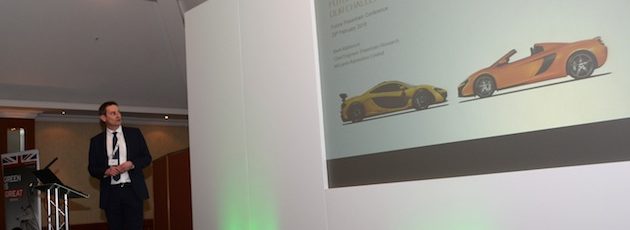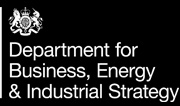
Event review: Future Powertrain Conference review, 25/26 February 2015, Solihull
The Future Powertrain Conference took place at the National Motorcycle Museum in Solihull on 25th & 26th February 2015, and it brought together academics and engineers from the automotive industry with the aim of jointly exploring solutions for future powertrain challenges
A number of interesting ideas were presented in the various sessions, ranging from removing the need for vehicle brake pedals, to vehicle drivers themselves not being needed – all in the quest for greater efficiency.
Professor Matthias Wellers, Managing Director, AVL Powertrain UK, welcomed delegates to the event and reminded the audience that road transport is responsible for 16% of man-made CO2 emissions. He also highlighted the huge growth in demand for vehicles from markets such as China, meaning that just to maintain overall global CO2 emissions, a massive reduction in emissions from individual vehicles would be needed.
The roadmap to achieve such emission reductions is well known in the industry: more hybridisation and electrification is needed. But a roadmap is one thing; engineers still need to find ways to develop new low emission powertrains whilst giving motorists the levels of performance – and cost of ownership – that they want.
The keynote address was from a somewhat unusual speaker for a vehicle powertrain event: the British Ambassador to the Republic of Austria, Susan le Jeune d’Allegeershecque; the name is marginally easier to spell than to pronounce. Apart from giving delegates a tantalising insight into the fascinating world of diplomats, Susan (who explained that she was born in the UK before gaining her surname through marriage) highlighted the size and the success of the UK automotive industry, and the importance of university research.
She also explained that a key aim of the UK government is to create a bridge from innovation to industrial-scale manufacturing – which creates jobs. A significant section of this ‘bridge over the valley of death’ is being addressed by the Advanced Propulsion Centre (APC). The APC – a ten-year, £1 billion industry/government initiative – provides funding to assist organisations that have an idea for new low emission powertrain technology, in order to progress it to market more quickly.
An example of how a company has developed a new idea and successfully brought it to market in a relatively short timeframe was provided by Mark Mathieson from McLaren. The current McLaren business of developing road cars was only started in 2007 – just prior to one of the most severe recessions in recent times – yet just eight years later, the company has brought amazing new products such as the P1 and 650S to market, and the company is debt-free and making profits.
Mark suggested that McLaren had to move very quickly because the world is moving very quickly – the rate of change in areas such as communications/connectivity, energy and social behaviours is so rapid – and the next ten years will be even faster, with one thing being certain: with social trends such as megacities on the horizon, the world can’t have polluting vehicles.
Mark saw that the downsizing of the internal combustion engine would continue, and electrification seems inevitable – but electric vehicles, and range extenders, would get simpler. The overall outcome of a hybrid system would have to be to contribute to faster lap times rather than to add weight. Transmissions would become more important than ever, as they are becoming a ‘torque junction’ between the different elements of a vehicle’s powertrain.
Successful development of all this complexity would require joint ventures – especially for relatively small manufacturers such as McLaren. Again, this is an area where the APC can help, by bringing partners together and providing funding support to develop new technology. Mark concluded by saying that there are huge opportunities for companies that are first to market with new technology.
It was refreshing to hear another speaker continue the theme of ‘performance, efficiency and fun’. Jon Hilton from the Torotrak Group presented about flywheel energy storage – ie. catching engine braking and returning it back to the wheels. Jon makes no secret of his liking for cars that offer power and fun, and he believes that this can be achieved with lower emissions by adopting flywheel energy storage systems. As well as providing a power boost, flywheel KERS can also provide braking – in fact theoretically, if fitted with such a system, a vehicle could have no need for a brake pedal.
Although such systems offer advantages in motorsport and performance cars, they can reduce the emissions of other vehicles such as buses. In fact Torotrak and its partner JCB have received funding from the APC (a £3.3 million grant as part of a £7.2 million project) to apply Formula 1 technology for use in excavators. This will lower fuel consumption and CO2 emissions, resulting in a substantially reduced carbon footprint for construction projects using this machinery. On average, the carbon emissions of a single 20 tonne excavator will be reduced by an estimated 16 tonnes per year.
On the subject of excavators, Dr Lou Balmer-Millar presented about the initiatives that Caterpillar is implementing to improve off-road fuel efficiency. The company is introducing a range of technologies including hybrid excavators, which can demonstrate up to 50% better fuel economy. However one of the more interesting findings was that a 250 tonne quarry truck is more efficient when it drives itself rather than being driven by a human. The fully autonomous mining truck doesn’t make mistakes when navigating around the quarry – whereas drivers do – and the resultant fuel savings on a 250 tonne vehicle can be huge.
For many years the perception has been that academia has been carrying out its own research-related projects, and industry has been doing separate R&D, and the two have not worked together very closely. It seems at last that the Future Powertrain Conference is addressing this issue, in terms of the automotive industry at least, and bringing the two sides together to exchange knowledge and share ideas – in areas ranging from batteries to fuel cells.
Based on FPC2015, it looks like collaboration is accelerating, and that there is a good chance that new joint projects could be in the pipeline. Such projects could benefit from Advanced Propulsion Centre funding, helping to bring tomorrow’s ultra-low emission vehicles to market faster.
In terms of what the future holds, there seemed to be one clear answer: cleaner transport and increasing rates of change. The UK needs to be at the forefront of developing lower emission vehicles, and both the FPC and APC are playing a key role in helping to bring this about





